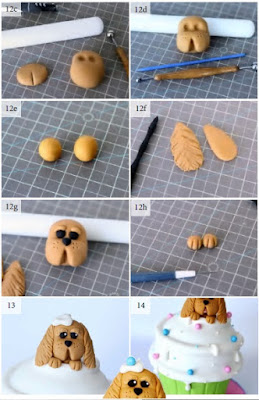We asked our readers
to create Giant
Cupcakes… with a
difference. We were
looking for cake
decorators to think
outside of the box, and
come up with some
designs that move away
from the traditional
Giant Cupcake. Here,
you will find no simple
sugarpaste or chocolate
cupcake bases with
piped buttercream on
top. Instead, we are
sharing the cupcakes
that really impressed
us with the ingenuity
and creativity of their
design. Here are some
of our favourites…
Anna Mathew Vadayatt
Cake Canvas – happiness in a box
“Anna was a Cake Masters Magazine
Modelling Excellence Finalist for the
2015 Awards, and you can totally
see why with this beautiful Manipuri
dancing girl giant cupcake. There is
a stunning attention to detail on the
model, who is poised and graceful,
and on the base that makes up the
girl’s flaring skirt, with those tiny
dots of royal icing.”
Ashwini Sarabhai
The Dream Cakes
“This rustic giant cupcake is a lovely,
subtle twist on the traditional. The
texture of the base and the unusual
placement of flowers at an angle
caught our eye. It is a pretty and
delicate design, with a soft addition
of colour from the flowers.”
Danielle Lechuga
Cup’N Cake
“With lots of elements that come
together as one gorgeous creation,
we love so many things about this
giant cupcake. The marbled effect
on the fondant top, the dripping
ganache on the cake and the cute
modelled girl on top are all great.
Little tricks like the continuity of
the wafer style board with the wafer
treats on the side with the lollies and
macarons, really bring the design
together. It’s fabulous
Linda Caro
Little Hunnys Cakery
“Inspired by her love of pasta,
Linda has transformed her giant
cupcake into a pot of spaghetti and
meatballs. We particularly like the
metallic silver achieved on the base,
the spaghetti detail and the grated
fondant on top that looks like cheese!
It’s a very creative design.”
Marina Danovska
“This giant cupcake is the diamond…
coming out the rock! We love how
completely different this is. A great
transformation that makes you
think of the extraordinary within the
ordinary.”
Loes Jakobs
LoveLicious Cakes
“Giant cupcake turned giant mug of
hot chocolate and whipped cream!
The pink and brown theme works
really well. We love how it is an
actual mug and looks good enough to
dig a spoon into and start drinking.”
Jana Hrubá
Jajiny Dortiky
“This comical creation is definitely
out of the box. We love the dress up
theme, with the cupcake base unsure
of which hat to put on and all of the
different choices. It’s quirky and
whimsical.”
Niqua Wheatley
Niqua’s Baking Addiction
“We love this design because of
how beautifully disguised the giant
cupcake is inside the ice cream! The
wafer cone base has a great texture
and the additional detail of the board
is a nice touch. It looks delicious.”
Joyce Marcellus
Toxic Sweets Shop
“We love the drama of this cake! The
top of the cupcake has a beautiful
bas-relief golden design and the
pinned brooch and feather detail
creates a lovely finish. With its
vintage flapper style, it’s a brilliantly
opulent hat on a stand and a great
twist on the giant cupcake.”
Nisha Fernando
Sweet Delights Cakery
“A magical fairy house nestled in an
enchanted forest in the middle of a
mystic pond, this giant cupcake truly
transports you to another world!
Every time you look at this exquisite
cake, you see more intricate details
that add to how impressed you are:
the texture of each roof tile, the
balancing of the house on the rock
tower, the shining green board that
creates the effect of the pond, the
delicate touches of the moss and the
door detail… the list just goes on!”
Tennille Russo
The Chantilly Kitchen
“Dreamy and magical, this giant
cupcake is like a work of cosmic art.
The painted work is charming and
the hanging stars add a lovely touch.
We love the beautiful deep colours
of the nebula. Simple but really
captivating!”
Raquel Ribeiro
Toque d’Açúcar
“Totally different from the rest of
the giant cupcakes submitted, this
hanging, steampunk take of a cuckoo
clock is fabulous! We love the tonal
colours of the clock and the little
bird, plus the detailing on
the wood and metal-effect
cupcake top. It is a great
interpretation of the
steampunk look.”
Sofia Salvador
Mnhammy
“It’s lovely to see the same texture
over the whole giant cupcake, and
the more complex woollen texture of
the cupcake base. It’s a really pretty
knitted design and the little boots
are so cute!”































